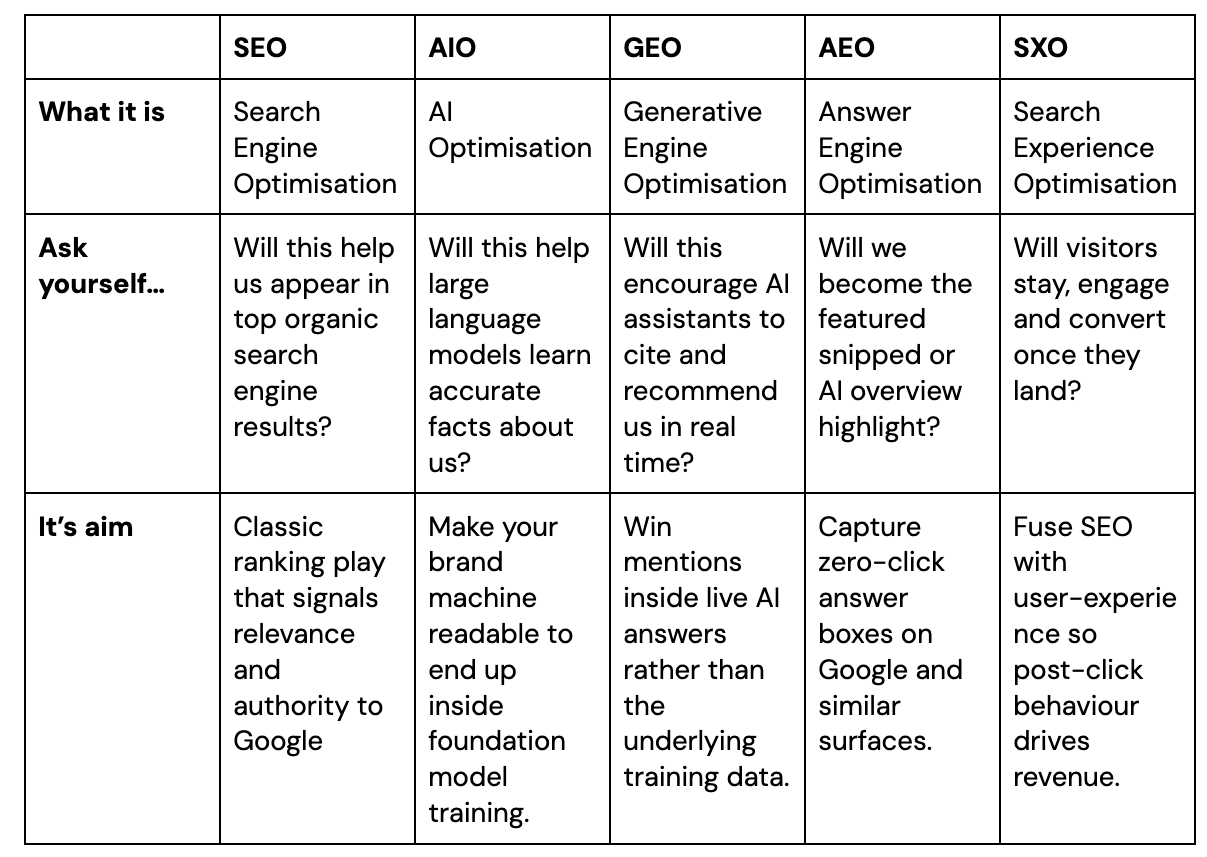
WTF is AEO and should startup founders care?
If you’ve heard AI is changing search but don’t know what to do about it, read this.
“How do we show up in ChatGPT?”
The founder asked me straight. And… I stumbled.
Not because I hadn’t thought about it. I had. A lot. But because I’d seen 442 conflicting answers.
At that point, every time I opened LinkedIn, someone was flogging “AI search secrets” or “AEO hacks”. They still are.
Every article seemed to contradict the last.
I’ve been in marketing for over a decade — SEO strategies, content plans, positioning workshops. But that simple question had me ummm-ing like Dennis Denuto on trial. Because 442 is a lot of answers to compress into one clear one.
So I did what any self-respecting marketer would do:
I went down a rabbit hole. Opened 224 Chrome tabs. Ate a packet of dark chocolate. (>80% cacao, always)
Cross-referenced everything I read, watched and listened to with the marketing fundamentals I know that have actually worked forever.
And wrote this article. If you’ve been wondering:
- Is SEO dead?
- Is AI replacing Google?
- Do I need to rethink everything?
This is for you. It’s the clear, structured answer I wish I had at that moment.
I went down the rabbit hole, so you don’t have to. If you’ve been wondering whether SEO still matters, what’s changed and what founders should actually do… pull up a pew.
In this no-BS guide, you’ll learn how to:
- Know if SEO still matters for your business (or if you can ignore it)
- Understand what AEO and GEO actually mean, in plain English
- Show up in the sources AI tools actually learn from (hint: not your homepage)
- Get cited in the right places, without chasing backlinks or traffic
- Avoid marketing drift and stop wasting time on tactics that don’t compound
No snake oil. No AI hacks. Just the stuff founders need to get discovered by people and machines.
First: does search even matter for your business?
Before you panic-Google “SEO vs AEO vs GEO,” ask:
- Do your customers Google the problem you solve?
E.g. “How do we explain what we do as a startup?” - Are they actively searching for what you sell?
E.g. “Marketing agency for early-stage startups” - Is search actually how people find companies like yours?
E.g. Founders Googling marketing agencies when they get stuck
If yes, then Search is a channel worth investing in, and therefore it’s worth understanding how search is changing, so your next investor update doesn’t include: “still figuring out discoverability.”
The acronym cheat sheet you don’t really need
AI, SEO, AIO, GEO, AEO, SXO, SxSW, OMFG it’s all a bit much for the average punter.

But here’s the truth:
You don’t need to memorise new acronyms. You just need to do the work.
Search is changing, but the fundamentals still win:
- Clarity beats cleverness
- Useful content beats keyword stuffing
- Saying something worth finding beats posting for volume
Google still dominates. But people are now asking ChatGPT. Claude. Perplexity. And they’re getting full answers back, not just links.
Which brings us back to the real question: What makes you worth showing up in the first place?
What makes you worth showing up in the first place?
Step 1: Say something worth finding
This isn’t about chasing algorithms. It’s about:
- Clear positioning
- Conveying a specific, informed point of view
- Talking about real problems in your audience’s language
SEO was never really about ticking boxes. It was about showing up where it matters, with the right message.
AI search hasn’t changed that. It’s just made substance non-negotiable.
Step 2: Get your house in order
Before you obsess over AI visibility, fix the basics:
- Is your value prop clear?
- Does your site load fast?
- Is your content structured logically (H1s, H2s, internal links)?
- Are AI crawlers allowed access? (Check robots.txt and llm.txt — don’t block them.)
- Is your site indexed by Google and Bing? (Use site:yourdomain.com to check.)
- Do your pages answer real questions, fast and clearly?
Write like a human:
- Front-load your headlines
- Use bullet points and clear subheads
- Cut the fluff
- Don’t keyword-stuff
This won’t get you found on its own. But it’ll stop you getting ruled out.
So how do you actually show up in AI tools?
Here’s the game:
- Show up in places AI models train on
- Get cited by sources they trust
- Say something clear, consistent and worth repeating
Not AI hacks. Just smart, deliberate visibility work.
Step 3: Choose your POV terms and say them everywhere
Pick 1–3 phrases you want to own:
- “Early-stage startup marketing”
- “Startup marketing foundations”
- “Startup growth strategy”
Not: “Disruptive synergy engine” (no one’s searching for that)
Then use them everywhere:
- Website copy
- LinkedIn posts
- Sales decks
- Email CTAs
- Podcasts
- Newsletters
- Event talks
Repetition builds recognition. Recognition builds reputation.
Step 4: Build your citation shelf
ChatGPT doesn’t learn from your homepage.
Perplexity doesn’t scrape your About page.
These models train on high-authority, public sources like:
- Wikipedia
- Reddit and Hacker News (especially thoughtful threads)
- Government and university sites (.gov, .edu)
- Credible news and media (AFR, NYT, TechCrunch)
- High-authority blogs and explainers
- Podcast metadata and YouTube transcripts
- Ecosystems like Quora, Medium, and academic citations
Your blog? Only if it gets cited somewhere else. (Example: Your AI search piece gets picked up by SmartCompany. Hello, citation shelf.)
So stop chasing clicks. Start earning citations.
Step 5: Get mentioned (yes, the hard part)
This is where most people stop. Don’t.
- Get featured on podcasts or panels in your space
- Share insights in public threads your audience trusts (Reddit, LinkedIn, community forums)
- Contribute to credible industry blogs or newsletters
- Be the founder that gets quoted in “what’s next in [your category]” roundups
You don’t need 100 mentions. You need 5 in the right places — the ones AI actually learns from.
Step 6: Format for humans and machines
Make your ideas easy to skim, cite and remember:
- Clear, front-loaded headlines
- Scannable structure
- Named ideas or frameworks
- FAQs with real answers
- Branded anchor text (use your name or company + the idea)
This isn’t over-optimising. It’s just making your thinking legible.
Step 7: Monitor and adapt
Every quarter or so:
- Google your POV terms
- Ask ChatGPT what it knows
- Check where you show up (or don’t)
If you’re not there yet. Don’t panic. Just keep going. This is compounding work.
What not to do
Please, no:
- “AI optimisation” snake oil
- Keyword stuffing
- Writing for AI instead of humans
- Spammy backlink schemes
There is no trick. Just do the work to show up in the places that shape the conversation.
Final thought: Don’t just show up. Be worth finding.
It’s possible that I’m still in a rabbit hole. Could be a wormhole. Might be a black hole. Hard to tell, but I’ve learnt a helluva lot down here. Spiralling less. Uncovering more. Ideally saving founders from the fate of learning it all the hard way.
In the land of SEO, AEO, GEO, LLMO, LMNOP… this whole thing started with ASQ (A Simple Question): “How do we show up in ChatGPT?”
Turns out, the real question is deeper: Are we saying something people, and machines, care enough to repeat?
You don’t get discovered by gaming a model. You get discovered by saying something useful, again and again, in places that matter.
This isn’t a guide for gaming AI. It’s a reminder of what good marketing has always been:
- Know what you stand for.
- Say it clearly.
- Show up where it matters.
- Earn your place in the conversation.
Not for the algorithm. But for the people who need what you’ve built.
See related articles


So you bought a booth at an important conference… now what?


When (and how) should DeepTech startups invest in marketing?


The secret to getting in front of customers: Category Entry Points
Ready to make sense of marketing?








